Last Updated on 12/11/2020 by Desmond
Gaiwan is a kind of traditional Chinese teaware, which consists of a lid, a bowl, and a saucer, respectively corresponding to the “sky,”” earth,” and the “man,” reflecting the traditional Chinese philosophy.
In some Chinese ancient-theme films, the characters often use the Gaiwan to make Gongfu tea. The Gaiwan can be used either as a teaware for individual drinking or a teapot substitute when having tea with friends.
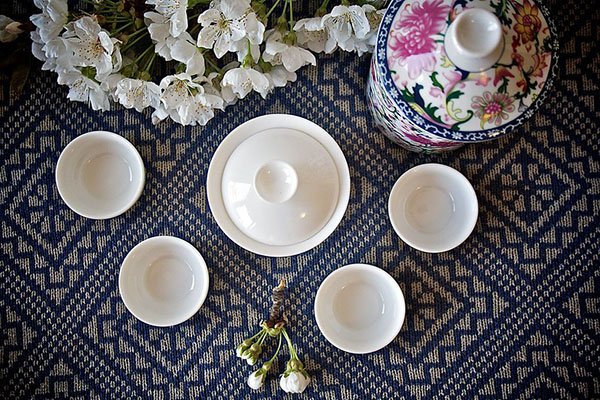
CONTENT
The Advantages Of Gaiwan
What are the advantages of a Gaiwan over a teapot?
Material
Gaiwan is usually made of porcelain, and some are made of glass. This material’s characteristic is within a smooth surface, not be full of tiny pores like the ceramic(Purple clay) one. This feature allows the Gaiwan to better keep the tea’s aroma and taste and is easy to clean without leaving tea stains.
Of course, the lack of tiny pores also makes the Gaiwan has a high thermal conductivity. When you brewing tea with it, if not in a proper way, it will be easy to burn your hands; Moreover, the Gaiwan is not conducive to the heat preservation of tea. High thermal conductivity will make the tea cool down quickly, so it is necessary to have it as soon as possible.
Bigger Opening
Gaiwan typically has a bigger opening than the teapot. It will be more comfortable on adding leaves or serving infusion, or the cleaning after having tea.
Especially when you need to add water, the design of the opening of the Gaiwan can make the tea leaves rotate better and release the tea juice more evenly.
Like the glass teaware, Gaiwan makes it easier to observe the leaves’ shape and color, thus judging the tea quality. The bigger openings also allow the aroma to permeate the air more when brewing the tea, which has a strong scent.
Great Design
The design of Gaiwan may seem ordinary, but in fact, it has incredible uses. When you use a Gaiwan to have tea alone, you can use the lid as a filter to push aside the leaves. The high thermal conductivity of Gaiwan makes the tea cool down quickly, and the tea saucer helps you hold it easily. Control the lid’s closure so that the tea leaves are filtered and let the tea slowly sip into your mouth.
When you have tea with your friends, you can also use the lid’s filter function to directly pour the tea into the fair cup. But this requires practice, or you get a hand burn.
One different from the teapot. After covering, a completely enclosed space forms inside the Gaiwan(the teapot still has an outlet to allow air to flow that can’t be regarded as a completely enclosed space). The wholly enclosed space can make tea heating faster and more thoroughly. And the aroma of tea will not be lost unless you move the lid away.
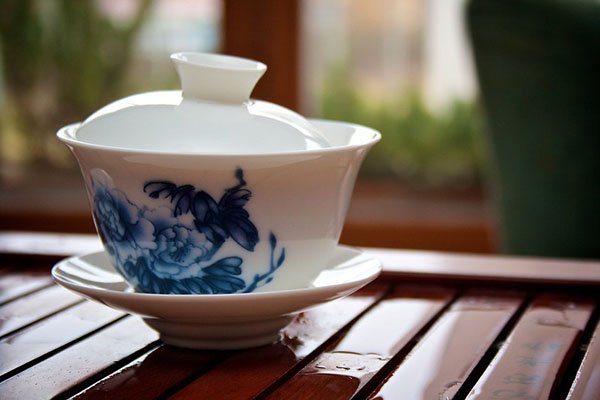
How To Use A Gaiwan To Brew Tea
Pre-heat
First, add boiling water into the Gaiwan, and then gently shake it 3 times to let the boiling water wash the inside. While cleaning and disinfecting the Gaiwan, it can also pre-heat it so that the water temperature will not be reduced when brewing tea.
Related Reading: How The Steeping Tea Temperature Affect Tea Quality?
Put The Leaves In
Put the appropriate amount of leaves into the Gaiwan according to different tea types and personal taste. The volume of the Gaiwan is usually smaller than the teapot, so do not add too many leaves, or the concentration of tea will become very high. The most ideal is the amount of tea that just covers the bottom of the Gaiwan.
Add Water
Many people will add water to the center of the Gaiwan when brewing tea. That cannot be said is wrong, but there is a better way.
Due to the “Y” shape design of the Gaiwan, we can slowly pour water into it from the edge of the bowl when adding. In this way, the water will form a vortex inside the bowl, causing the tea leaves to rotate and be heated more evenly, extracting the tea’s ingredients better. Pay attention to the amount of water; the water level should be kept below the lid position’s edge.
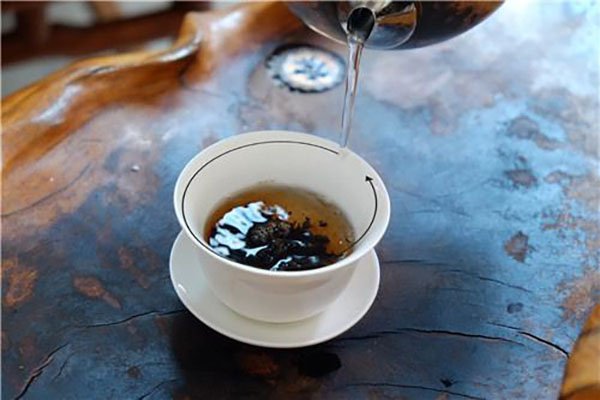
Cover
Cover it at once after adding water. Ensure the lid is covered close without any gap. It can help the leaves get the best steeping.
Enjoy Alone
After steeping for a time, you can pick the Gaiwan up with a saucer. Use the lid to push aside the leaves floating on the surface of the infusion. Then put your lips against the edge of the Gaiwan, gently tilt it and let the tea slowly flow into your mouth.
When drinking tea, hold the saucer with one hand and press the lid with the other hand to form an angle with the edge of the bowl to filter the tea leaves.
Enjoy Along
Pinch the tip with your thumb and middle finger on the Gaiwan’s edge, and tip the lid’s top with your index finger. Sliding the lid with your index finger, make a little gap, gently tilt it let the tea pours out slowly from the opening to the fair cup or the teacups.
This action needs practice, as an incorrect method can lead to scalding or breaking the Gaiwan. Note that the place thumb and middle finger pinching are not the body of Gaiwan but the edge. Because the temperature is relatively lower. The tilt angle is gradually increased when pouring out the tea. If making a big angle at first, the hot tea will surges out instant and burn your fingers.
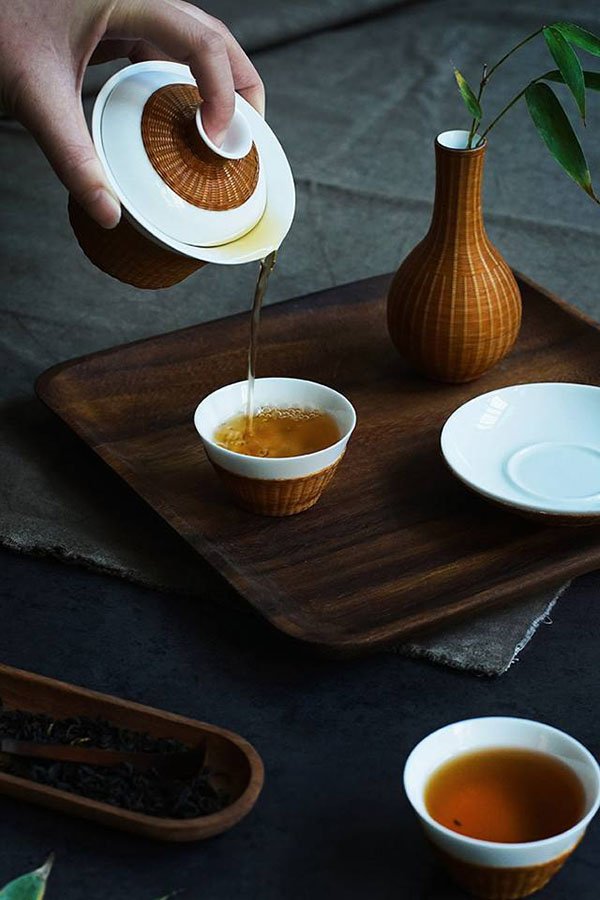
Gaiwan Buying Guide
When you going to get a Gaiwan, follow the 3 points below.
Size
There is no uniform standard for the size of a Gaiwan. The smaller the Gaiwan, the few tea it brews and increases the brewing times; The bigger the Gaiwan, the harder to hold, increase the risk of breakage.
Opening Diameter
The opening diameter of the Gaiwan also needs to note. Try to use your thumb and middle finger to touch the edge of the Gaiwan and pick it up to look if the size of diameter whether makes you hard to hold.
The bigger the opening diameter, the harder it is to hold. And suppose the opening diameter is too small. In that case, it will affect the Gaiwan’s barycenter, hard to pour the tea infusion out.
Lid
Look at the top of the lid, and we can see that it has a little widget. In addition to making it easy to pick up the lid, this widget is also the place you need to press over with your index finger while pouring the tea. Try pushing it with your index finger and sliding the lid to make sure it can slide smoothly.
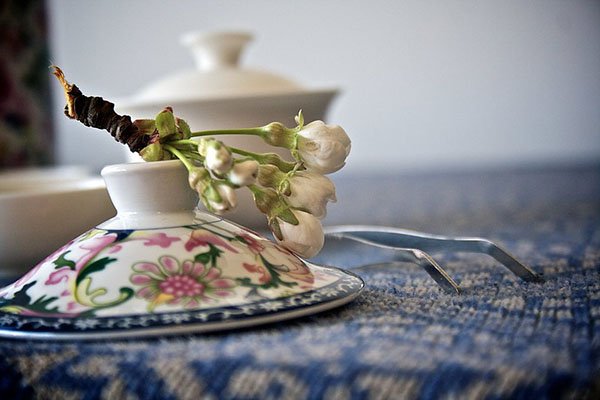
Observe the degree of closure between the lid and the Gaiwan is also essential. If there’s a gap between the lid and the Gaiwan after cover, it means that’s an inferior-quality product.